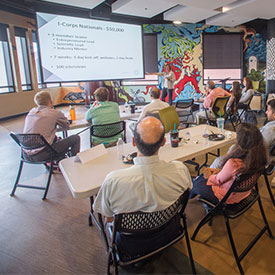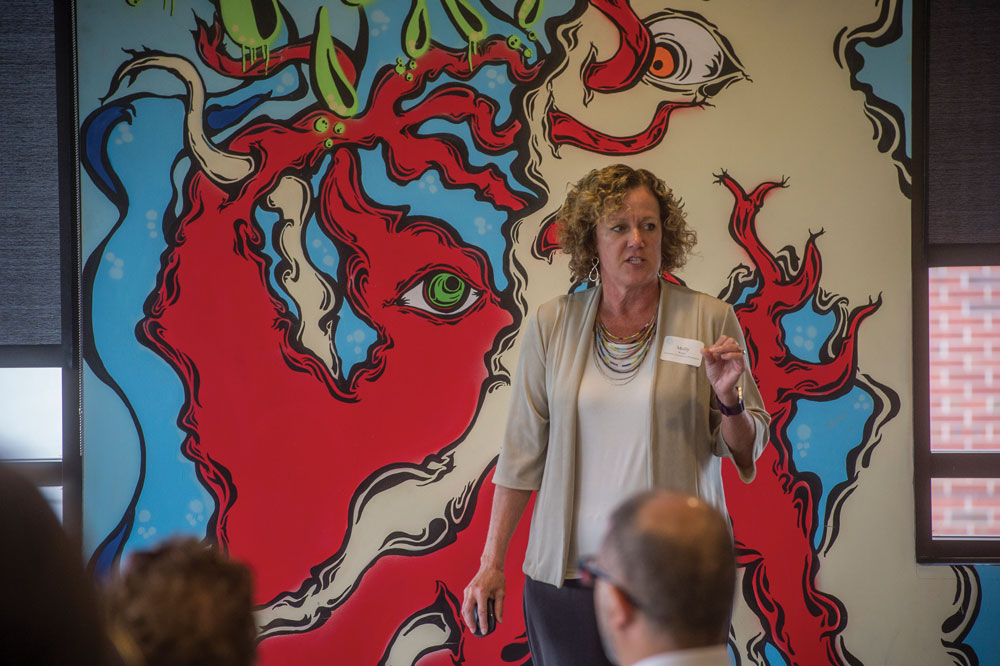 Participants in UAB’s first I-Corps training cohort for scientists and engineers learn strategies for bringing their innovations to the marketplace.With an estimated failure rate for business startups hovering anywhere from 50 to 90 percent, success requires plenty of inspiration, perspiration, and preparation. The latter is what UAB is hoping to bolster through a new relationship with Innovation Corps (I-Corps), a National Science Foundation (NSF)-sponsored program designed to help scientists and engineers take their research from the laboratory to the marketplace.
Participants in UAB’s first I-Corps training cohort for scientists and engineers learn strategies for bringing their innovations to the marketplace.With an estimated failure rate for business startups hovering anywhere from 50 to 90 percent, success requires plenty of inspiration, perspiration, and preparation. The latter is what UAB is hoping to bolster through a new relationship with Innovation Corps (I-Corps), a National Science Foundation (NSF)-sponsored program designed to help scientists and engineers take their research from the laboratory to the marketplace.
“We used to say, ‘Okay, you’ve got a great idea. Now spend tons of money, build a prototype, create a business plan, and take it to market,’” says Molly Wasko, Ph.D., professor and associate dean for research, innovation, and faculty success at the UAB Collat School of Business who oversaw the I-Corps implementation at UAB. “That system has failed.”
The problem, she explains, is not a lack of passion but the opposite—innovators who are so enamored with their ideas that they don’t stop to consider the value of their inventions to the market. “Our scientists have been working on problems that are interesting to them. But what if users don’t care in the long run?” Wasko questions. Indeed, a 2014 Fortune magazine poll that surveyed the founders of failed startups found the No. 1 reason for failure is the lack of a market need for the product.
UAB is an I-Corps site and a part of the I-Corps South Node, which includes The University of Alabama, Georgia Institute of Technology, and the University of Tennessee. There are eight nodes in the I-Corps program, which teaches scientists and engineers the steps required to succeed as entrepreneurs.
“It’s a completely different way of thinking for them,” Wasko says. “Scientists tend to believe that all they need to do is get FDA approval for their idea to make a gazillion dollars. I try to help them realize they don’t need to go through the difficult process of getting FDA approval unless they’re certain there’s a market for the product. Lots of things have FDA approval that have never come to market.”
For that reason, the I-Corps program emphasizes viability over other concerns. “We are completely technology agnostic; we can teach this entire process without knowing anything about the technology,” she explains. “This is the toughest thing for scientists to understand, because they have only been trained to talk about the technology. But we stop them and ask, ‘What’s the problem you’re trying to solve? Who cares about it, and why does that person care about it?’”
Business Boot Camp
 Molly Wasko of the UAB Collat School of Business is overseeing the I-Corps program at UAB.Robert Hergenrother, Ph.D.—a professor in the Department of Biomedical Engineering and director of AIMTech (the Alliance for Innovative Medical Technology), a medical device development collaboration between Southern Research and UAB—has attended I-Corps events before and was enthusiastic about seeing the program introduced at UAB. As an engineer, he says he understands it can be hard to get past the “If you build it, they will come” mentality.
Molly Wasko of the UAB Collat School of Business is overseeing the I-Corps program at UAB.Robert Hergenrother, Ph.D.—a professor in the Department of Biomedical Engineering and director of AIMTech (the Alliance for Innovative Medical Technology), a medical device development collaboration between Southern Research and UAB—has attended I-Corps events before and was enthusiastic about seeing the program introduced at UAB. As an engineer, he says he understands it can be hard to get past the “If you build it, they will come” mentality.
“You can get very caught up in how great your technology or your invention is, but you need to step back and listen to your potential customers,” Hergenrother explains. “Are you meeting their needs? Do they agree that what you’re proposing a solution to is actually a problem?”
As an I-Corps site and a member of the I-Corps South Node, UAB is now hosting entrepreneurial boot camps (or cohorts), where teams workshop their ideas, test them against hurdles they are likely to face, and assemble “Shark Tank”-style presentations for feedback. UAB can recommend top teams for the National I-Corps program, qualifying those teams for grants up to $50,000.
UAB held its first cohort in June, and Hergenrother served as the entrepreneurial lead (or mentor) for Team Slip/Stick. Their idea—which came out of a lab directed by David Brown, PT, Ph.D., FAPTA, professor and program director for the Ph.D. in Rehabilitation Science Program in the UAB School of Health Professions—is for a shoe insert designed to help people with walking disabilities avoid favoring one leg over the other.
Hergenrother says the program enabled them to refine their target market tremendously. “In talking with physical therapists about their rehabilitation efforts, the target got whittled down to stroke survivors who have some sort of walking deficit rather than just anyone who has trouble walking,” Hergenrother explains.
According to Wasko, this is partly because stroke survivors are more invested in avoiding the use of canes or walkers. “For them, the value proposition is how they’re perceived,” she says. “They don’t want to look feeble.”
Campuswide Impact
Beyond the cohorts, UAB is sharing the I-Corps curriculum across campus in a variety of ways. The university is offering related undergraduate and graduate courses—both new this year—as well as a master’s program in the School of Engineering with a graduate certificate in Technology Commercialization and Entrepreneurship. Beginning this fall, UAB will also host a series of four-week, not-for-credit I-Corps sessions at Innovation Depot, a business incubation hub in downtown Birmingham.
The UAB Center for Clinical and Translational Science (CCTS) is also leading a national effort to adapt I-Corps training for the translation of biomedical discoveries. Robert Kimberly, M.D., director of the CCTS, senior associate dean for Clinical and Translational Research for the School of Medicine, and holder of the Howard L. Holley Research Chair in Rheumatology, points out that the same concepts apply whether a discovery has potential commercial value or advances ideas that can improve public health. “In terms of developing the perspective that I-Corp brings, it’s a bit more concrete when you talk about engineering,” he says. “One makes a device and presumably it addresses the consumers’ needs and fixes the issues. Sometimes in the life sciences the questions and the approaches are not quite so discrete. Therefore, we initially considered if that same perspective would apply.”
And Kimberly says he believes that the answer is yes. He notes it may take more work to refine the I-Corps approach as compared to the engineering and physical sciences. It takes ideation, solution and development, refinement with iteration, and then application.
“Sometimes folks think commercialization is the only end game, but I prefer to think of the I-Corps philosophy as helping people understand what problems they’re going to solve, what gaps in knowledge or practice they need to address, and how to help address them,” Kimberly says. “Even if one isn’t interested in ultimately having a commercialized end product, it’s about getting people to think about the next steps. And that’s very important.
“Although I think doing science is its own reward, we have sponsors through the NIH and other agencies. We owe it to them, Congress, and people everywhere to do what we can to make sure we advance this research in the service of improving health.”
By Rosalind Fournier